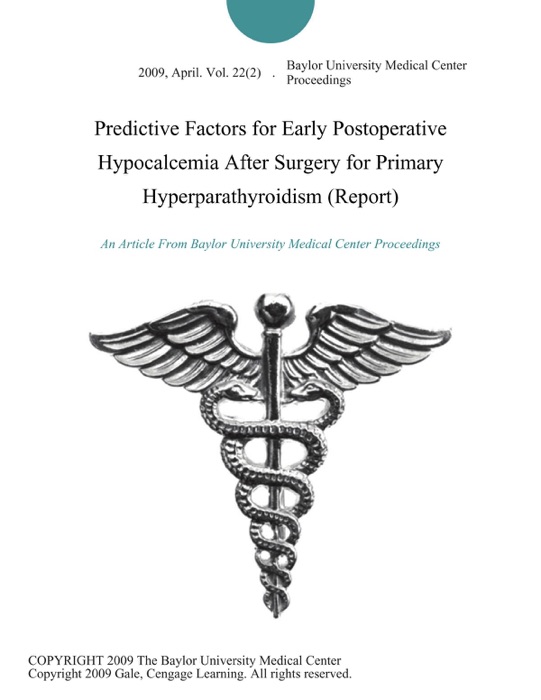(Download) "Predictive Factors for Early Postoperative Hypocalcemia After Surgery for Primary Hyperparathyroidism (Report)" by Baylor University Medical Center Proceedings * Book PDF Kindle ePub Free

eBook details
- Title: Predictive Factors for Early Postoperative Hypocalcemia After Surgery for Primary Hyperparathyroidism (Report)
- Author : Baylor University Medical Center Proceedings
- Release Date : January 01, 2009
- Genre: Health & Fitness,Books,Health, Mind & Body,
- Pages : * pages
- Size : 225 KB
Description
Surgery remains the most effective treatment for hyperparathyroidism. The incidence of hyperparathyroidism is increasing secondary to increased detection, technological advances, awareness by providers, and routine serum calcium screening (1). While early guidelines suggested surgery in those with symptoms or significant hypercalcemia, more recent evidence suggests that earlier intervention in "asymptomatic" patients may prevent long-term complications such as bone disease, psychological morbidity, and possibly excess cardiovascular risk (2). The current move is away from traditional four-gland exploration into minimally invasive parathyroidectomy (2, 3). Proponents of minimally invasive parathyroidectomy feel that cure rates of over 95% comparable to four-gland exploration can be achieved with lower complication rates (2). Successful parathyroid surgery in this new paradigm relies on recent technological advances including focused ultrasound, [sup.99m] technetium sestamibi scans, and the use of intraoperative parathyroid hormone (IOPTH). The combination of these technologies has proven better than using any one of them alone. For example, relying on sestamibi imaging alone can lead to failure, as 39% to 75% of multigland cases have solitary uptake on sestamibi imaging (3). The use of IOPTH in addition to good preoperative imaging can help reduce surgical failures. The concept of IOPTH was first described by Nussbaum at Massachusetts General Hospital in 1988 (3). Parathyroid hormone (PTH) has a half-life as short as 1 to 3 minutes, which allows a drop in hormone levels to be measured on a clinically useful level during surgery (3, 4). The technique of using a two-site immunochemiluminometric assay to measure the active component of PTH (intact PTH) can provide IOPTH levels in as little as 15 minutes (3). Previous data analyzed from our institution have shown that in primary hyperparathyroidism, 90% of patients have appropriate assay decline by 5 minutes, and only 8% need the full 10 minutes to show adequate decline in PTH levels (5).
Post a Comment for "(Download) "Predictive Factors for Early Postoperative Hypocalcemia After Surgery for Primary Hyperparathyroidism (Report)" by Baylor University Medical Center Proceedings * Book PDF Kindle ePub Free"